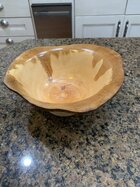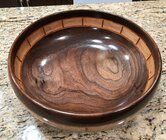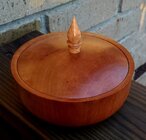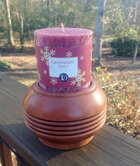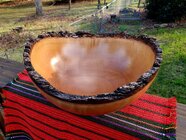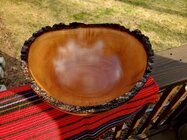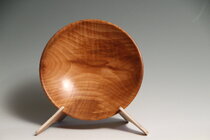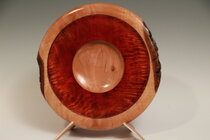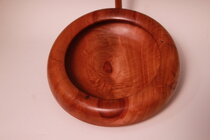I've seen threads on turning Bradford Pear, and I gather that it's a good wood to work. For those of you who have turned it, is the grain very interesting?
-
December 2025 Turning Challenge: Single Tree! (click here for details) -
Congratulations to Bob Henrickson, People's Choice in the November 2025 Turning Challenge (click here for details) -
Congratulations to Guillaume Fontaine for "Old Tea Pot" being selected as Turning of the Week for December 15, 2025 (click here for details) -
Welcome new registering member. Your username must be your real First and Last name (for example: John Doe). "Screen names" and "handles" are not allowed and your registration will be deleted if you don't use your real name. Also, do not use all caps nor all lower case.
You are using an out of date browser. It may not display this or other websites correctly.
You should upgrade or use an alternative browser.
You should upgrade or use an alternative browser.
Is Bradford Pear interesting?
- Thread starter Ken Loy
- Start date
I've seen threads on turning Bradford Pear, and I gather that it's a good wood to work. For those of you who have turned it, is the grain very interesting?
I like turning Bradford Pear, hard and fine grained. However, all the the wood I've had or seen was fairly bland without figure and without much character. I like the wood a lot more than I like the trees!
Holds detail well, great for spindle turning. It's good for carving, although it's a lot different than carving softer wood.
I made this a long time ago after seeing a demo by John Lucas on turning a bowl with handles and feet. Kind of strange, but hey.
The 2nd picture is of the piece turned before hollowing the inside and starting on the carving.
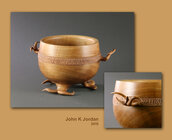
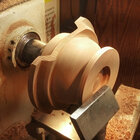
A lot of Bradford Pear trees were planted before people found out about the problems. Now even the towns around here are taking them out.
JKJ
Simple answer as above with JKJ -- no. But it turns beautifully, and sands very easily to a silky surface. I use it as much for jam chucks etc as 'proper turnings'. I had a large one in front yard self-destruct in an ice storm. Still haven't used all of it.I've seen threads on turning Bradford Pear, and I gather that it's a good wood to work. For those of you who have turned it, is the grain very interesting?
Donna Banfield
TOTW Team
When Bradford Pear is desired for turning, it’s exactly because of the bland nature of the wood. It is preferred for artists who do surface embellishments - Baskets of Illusion, carved, pierced and painted surfaces. You don’t need to deal with highly figured wood, which can make all those surface embellishments more challenging than they already are with plain grain, closed pour wood.
I've turned quite a bit of it. It's fun and easy to turn but I quit working with it for once turned pieces. Quite often it develops a thick brown rough oxidation layer (that's what I call it) while drying that is very difficult to sand away consistently. You either leave it, not pretty, or sand it all off all over the piece. I've quit on some pieces. For twice turned pieces like traditional bowls it's not great re grain but has a nice look for a utility bowl.
I, too, have turned quite a bit of it. I like it for natural edge bowls as it retains it's bark well.
Last edited:
Bradford pear is one of my favorites. I do a lot of embellishment, carving, pyrography, etc. Ditto all the above comments. There is some figure in crotch pieces, which are quite common since BP is mostly limbs.
As we have so much of it around here and it has recently been outlawed in SC, I get a lot of it from my tree-man neighbor. It is one of my favorite domestic hardwoods, especially twice-turned live-edge; as Wally mentioned, it retains its bark even on summer-felled trees. And though it is prone to developing that unsightly staining/oxidation as Randy noted, it is also very dense, hard and close-grained, and can take a finish almost like a fine porcelain. And if you can cut blanks closer to the pith and somehow get them dry without it cracking too much (which is a challenge, as it moves a LOT as it shrinks-make your rough-turns a bit thicker to account for this), it often glows with deep russet, pink and red hues that can look like a sunset like the candle holder and the lidded bowl I turned for last winter's Christmas markets.
I am in the final finish stage on a large live-edge that actually has some nice curly figure. I will upload pics later. I hope this helps.
I am in the final finish stage on a large live-edge that actually has some nice curly figure. I will upload pics later. I hope this helps.
Attachments
This is the one I'm finishing up. I have found that bradford pear looks far better and practically glows with all of its colors with a glossy finish befitting its glorious creamy surface. For this one I am burnishing in several coats of thinned TruOil gunstock finish with 0000-steel wool and cheesecloth for the final burnish once it's cured. I did a couple from the same tree in more of a "satin glow" type of finish with Tried and True Danish Oil, but I felt they would have looked better with the TO. Much of the main trunk of this tree sports some nice curl; a nice hand-rubbed finish really brings out the fire. Two unfortunate radial cracks were filled with colored epoxy, and that's the downside of leaving in some pith, but it's just so dang pretty, and there's no way I was giving up on wood this pretty.
Attachments
There is some figure in crotch pieces, which are quite common since BP is mostly limbs.
This is true, I've found a little, but around here at least, the crotches tend to have bark and cracks due to the way these trees tend to grow, one of the reasons the limbs break so easy and why they are being removed. Just one.
JKJ
Aaron, very nice pieces.
Great advice, everyone. Thank you for saving me the trip to pick up some free logs and process them. I've got enough blanks already! Now I don't feel guilty.
Thanks, Randy!Aaron, very nice pieces.
I like turning Bradford Pear, hard and fine grained. However, all the the wood I've had or seen was fairly bland without figure and without much character. I like the wood a lot more than I like the trees!
Holds detail well, great for spindle turning. It's good for carving, although it's a lot different than carving softer wood.
I made this a long time ago after seeing a demo by John Lucas on turning a bowl with handles and feet. Kind of strange, but hey.
The 2nd picture is of the piece turned before hollowing the inside and starting on the carving.
View attachment 73490 View attachment 73491
A lot of Bradford Pear trees were planted before people found out about the problems. Now even the towns around here are taking them out.
JKJ
The quality of your work never ceases to amaze me, John. That bowl with those carved (I assume?) handles...stunning. Oh, if I had a third of your skill...
The quality of your work never ceases to amaze me, John. That bowl with those carved (I assume?) handles...stunning. Oh, if I had a third of your skill...
Thanks, and HA! I didn't mention I spent about 100 hours on that. Beside being the slowest turner in the Southeast, I'm a slow sander and very slow at carving.
I'd never seen a bowl with handles and feet until John Lucas did a demo at our club of the process years ago (with simple straight feet and handles to make the demo fit into the time). While watching, I thought to myself: "Self, we should make one with some more organic shapes - I know, claw feet, you know, eagle claws around balls!".
When I told John after the demo I'd like to try one with more organic shapes, he said he did too, I maybe some claw feet! Oh no, after that I couldn't possibly carve claw feet or it would look like I was stealing his idea.
For those who haven't tried one, the hardest thing for me was turning so carving away between the feet would give a nice continuous curve to the bottom when the "foot ring" was carved away between the feet. I decided to cheat a bit at the top and make use a raised stippled band to separate the rim from the rest of the bowl - I think I like it better that way than if it were a smooth, continuous curve. I may try that on a "normal" bowl sometimes. (I do the stippling a lot on wands, tool handles, bottle stoppers, and other things - use a small oval-shaped carbide bit on a Dremel and make a series of somewhat random dimples, then lightly sand with 600 grit paper backed by fingers.)
Good clean fun!
(PS: if you ever have the opportunity to catch a John Lucas demo don't miss it! Excellent and creative teacher. He's scheduled to show inside-out turnings in Knoxville next Tue. Or see if you can book him for your club!)
JKJ
- Joined
- Feb 28, 2021
- Messages
- 1,771
- Likes
- 1,585
- Location
- Roulette, PA
- Website
- www.reallyruralwoodworks.com
When I saw your photos above, my first thought was "Nice Quaich" (Look up Quaich, for those interested) - Bowl With Handles, in other words..I'd never seen a bowl with handles and feet until John Lucas did a demo at our club of the process years ago (with simple straight feet and handles to make the demo fit into the time). While watching, I thought to myself: "Self, we should make one with some more organic shapes - I know, claw feet, you know, eagle claws around balls!".
- Joined
- Feb 6, 2010
- Messages
- 3,454
- Likes
- 2,523
- Location
- Brandon, MS
- Website
- threeringswoodshop.square.site

